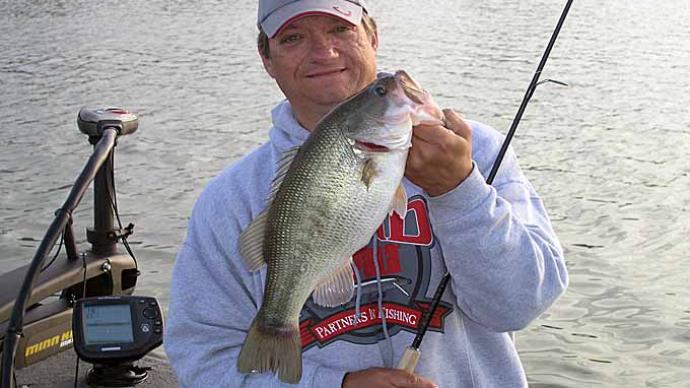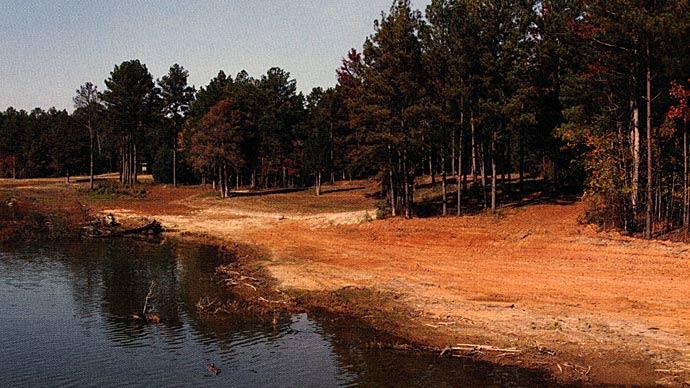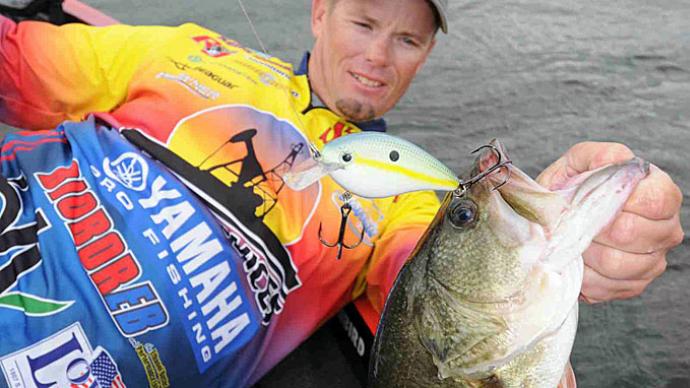
Falling Waters: Frank Lloyd Wright's architectural masterpiece, blending the artistry of human design with Nature's ever-changing sounds and beauty. A house forever in motion, for Nature begins to move when waters fall or recede. Food chains react, predators adapt, and everywhere Nature is on the move.
Water falls in fall—in most places, that is. And like Wright's architecture, the falling waters we fish are in part natural design, in part, our design. Sometimes the long, hot summer takes its toll, and lakes reach low pool until spring melt replenishes the supply. Other times, the water's drawn down—a purposeful plan to make way for winter rains and spring runoff.
As anglers, fall always presents a unique challenge. Low or falling waters shrink habitat. Sometimes it concentrates fish; other times, it scatters them. But the common fishing thread always rings true—find the bait, find the bass.
Really, in preparing to fish in these unique conditions, a central focus on bait is the right approach. Forever on the run, at bay from marauding bass shad, are the real players in this low-water game.
Their annual fall migration to skinny-water coves, creeks, and flats often intersects these fortuitous drawdowns and dwindling water supplies. Sometimes in only inches of water, shad are so easily found that it makes the job of bass angling much easier.
Faced with miles of water, only the in-tune angler can quickly find and tap the fall-bass bite.
Bass West found four and formed an in-tune quartet of anglers who've made their living on Western lakes and cashed many a check while fishing falling water. As a group, they're the best and brightest, and their willingness to share hardcore inside tactics instantly makes finding fall bass much easier.
Grab a chair; you're about to glean information your peers have never sat privy to.
John Murray: Dissecting The Desert Drawdown
"The first thing to address is the falling water conditions in the desert impoundments. I'm used to fishing in Mexico, New Mexico, Arizona, etc. I'm talking canyon-type impoundments, where they can yank the plug and pull three to six inches of water daily.
"One of the biggest misconceptions is to head right for the steep banks because 'that's where the deep-water bass will be.' I used to follow that rule until I ran into a tournament years ago at Caballo Reservoir in New Mexico. The water had fallen six inches daily for a couple of weeks, and the lake featured steep and flat sides. To make a long story short, I fished the steep side, and everyone who finished in the top five fished the flattest banks they could find.
"What had happened was the crawdads living along the banks became exposed. Remember, on a steep bank, the water might fall only three inches, while along a flat bank, it might fall a foot or more. As it turned out, the feeding bass were along those flat banks, feeding on the newly exposed forage.
"In the past few months, Lake Mead saw a similar situation, with the feeding fish cruising the flatter banks. It's a subtle difference, but I believe that while bass may be along steep banks during falling water, the feeding bass want the flats. And they'll be in the shallowest water imaginable.
"Find those feeding fish, and the catching's easy. It depends on the weather, but topwaters and ripbaits will take them if it's still warm. Cooler weather and water in the low-60s calls for Rat-L-Traps and spinnerbaits. Ensure your spinnerbait is constantly in contact with the bottom, stirring it up. If you have to go with finesse, throw a Senko. Pitch it right up on the bank and twitch it into the water. At Lake Powell, I'll toss jigs and spider jigs the same way—pitching them onto the bank and pulling them into the water.
"Overall, I would have to say that rising water creates a better bite because all the deep-water fish will come up to the bank, but if you pay attention to what's happening in the lake and capitalize on the brief window that opens, you'll have great days with falling water, too.
"Stay on top of conditions, though. I receive emails from the U.S. Bureau of Reclamation that provide water-release information. I also check online—the Arizona Republic provides good state lake conditions coverage. Use your eyes, too, and watch the banks when you launch and as you fish.
Brett Hite: Low Water Lakes, Rivers Too
"I feel there are two different types of falling water. One occurs in lakes, the other in rivers. The fish tend to back off and move deeper when water is falling in lakes. So as the water goes down, the fish go down further.
"That's in lakes and during any time of year, including summer droughts. But in rivers, the bass stay right up on the bank the whole time—in water as skinny as six inches. The key, though, is to find those banks located near deep water. Then, in case the water falls, fish want an escape route. This is a common occurrence on Havasu, for instance.
"These bass will be feeding, too, so I go down those riverbanks and try to find a little flat that drops off into a deep spot. That's always a good spot for river fish. And if you can find structure or cover like rocks or stumps, the more, the better. Good baits in these areas are your pitching and flipping baits and rattle baits.
"Lakes are different. Out West, the fall patterns branch into two extremes. Beginning about the middle of October, the lakes aren't falling anymore, but you will be faced with very low water. I've found that fish are either very shallow or very deep.
"When they're shallow, you can catch them on topwaters and jerkbaits. A lot of the softer baits work well, too. But for those deep fish, my number-one deal is the dropshot. I grew up spooning, and it's effective, but today, I can't see spoons even comparing to a dropshot. Plus, we killed too many fish on spoons—you just reel them up too fast—but with the lighter dropshot rigs, mortality isn't a big problem.
"I also like to Carolina rig down deep. And I mean deep. I'm talking 30 to 65 feet, where they're feeding on shad near humps and deep points.
"My dropshot setup has changed a little in recent years. For nose-hooking, I use a size 0 Nogales hook made in Japan. It's a thin-wire hook that's a little different than the others. On the other hand, if I'm Texas rigging my dropshot in cover or maybe targeting larger fish, I use the Roboworm Gamakatsu ReBarb hook.
"And I just won a few tournaments in Southern California with a dropshot bait made by Big Bite Baits, called a Jointed Jerk Minnow. It's an in-between bait—perfect for when you don't know whether to throw a worm or a reaper. It looks like a shad, and the clear-water color patterns are fantastic. I also like to dropshot Big Bite Baits Scentsation SoMolly in the Smashed Goby color. Finally, of course, the Big Bite Baits Scentsation Cliff Hanger Worm is also a go-to bait.
"As November comes on, most of the largemouths start to move off the main-lake structures and head into the creek arms and channels, chasing the migrating shad. I tend to find the bass first in the big main-lake coves, then later in the creek arms. The creek channels are like highways: fish follow them, and you have to follow them, too. So the bass will keep following those creek channels up through the winter until it's time to spawn.
"The key to fishing channels is to find an S-bend or other sharp turn. At every creek bend, there will be an outside bend and an inside bend, and the outside is almost always a steeper drop-off. Of course, the insides will have a distinct point, but I prefer fishing the outside bends. Unless, of course, they're up on the flats."
Ish Monroe: Cripple Bait Creeks
"Falling water puts fish in motion. Sometimes it causes the fish to go into a feeding frenzy. Other times, it makes them picky to the point where they'll hardly eat at all. If you've ever pulled the water out of a fish tank, you've seen your fish swimming around in circles. Like your tank cleaning, the standard drawdown in a lake puts the fish in motion.
"This means you'll have to cover much water when levels fall. But once the water becomes stable, the fish often back up on the available structure and cover. There's much less of it, though, and it makes them easier to locate.
"I try to keep an eye on the creek-arm bite. When water temperatures dip into the high 50s—like 58 to 60—that triggers the fish, and the creek-arm bite gets hot.
"A lot of the creeks will be drying up this time of year, so I start looking for the deeper creek arms, and I generally follow the channel as far back as I can—trying to fish in the creek channel itself, rather than up on the flats. But, of course, if fish are feeding on the flats, I'll fish up there.
"Shasta and Oroville are good examples. Targeting the creek arms puts you on largemouths—rather than spots that stick more to the main lake—and you'll weigh bigger bags.
"Since the fish chase shad, I like Cordell Super Spots or Fat-Free Shads. However, cripple baits like a Zara Spook, Pop-R, or Devil's Horse are great when fish are breaking. If you can find breaking bait and bass, you've struck gold.
"As the day progresses and the water warms slightly, the big fish start coming up. Expect most of your better fish, especially the topwater fish, to come in the afternoon. Fish the banks, flats, and any available cover, and don't be afraid of real skinny water and the noisy baits I mentioned above.
"For example, I remember fishing at the BASS tournament on Shasta three years ago. I was in third place after the first day because, after I caught my limit, I ran to the back of the Sacramento arm and caught a largemouth close to 5 pounds. And I caught that fish out of only a foot of water!"
Luke Clausen: Two-Pronged Attack, Starting At The Bank
"Whenever lakes approach low pools, there are diminished cover opportunities, so more fish tend to move out and suspend. Finding and locating these scattering fish is more challenging because there's no cover to hold them. They're just swimming around chasing bait, but at some point in the day, they'll pull up on key areas—either along the bank or deeper structure—and feed.
"Keeping that in mind, I start fishing shallow and fast to see if I can get a bite. Especially in later fall, the more water I cover, the better chance I have of catching the quality fish that have come up to feed. Spinnerbaits, buzzbaits, jerkbaits, and topwaters will let you cover water the fastest. With wind, I like the spinnerbait or jerkbait; calmer conditions call for topwater.
"And I'm fishing fast. I get on 75 percent of my trolling motor, position five feet off the bank, and start firing casts at 45-degree angles or less. The fish will generally hit your bait only a foot off the bank.
"You'll get a lot of banks where you can pattern fish on chunk rock, or at Shasta or Oroville, red clay. Sometimes, you can fish those lakes and catch fish off every red-clay bank or steep rock bank. And remember, fish may prefer the flatter banks during sunny afternoons in late fall.
"If I can't get the bank bite going, I'll move off and start probing deeper structure because generally, if fish slide deep, it's pretty obvious where they'll be. You can often locate vast flats with water moving off of them. Then, as the water drops or settles, bait and forage come off those same flats, and the bass will be nearby. I also use a spider jig to explore offshore rockpiles and long tapering points.
"Another situation is fishing rivers like the Columbia, where water level and current flow are crucial to the bite. I used to live a few hours from the Columbia, and the water in fall gets a little lower but not drastically low, as you see down here. Then, in late fall, the current also starts to slow, and the fish scatter.
"It's primarily a deep bite this time of year on the Columbia, and most guys get on them pretty well. The bite's based on rock—especially in the Tri-Cities and Boardman pools—and the smallies are deep.
"Most guys cast or drift tubes, but they overlook an excellent bite. Ever since BASS swung through, the dropshot has been gaining ground. Along the small rockpiles and basaltic humps, anglers are drop-shotting many smallies behind other boats tossing tubes and Carolina rigs.
"Walleye anglers discovered another overlooked bite on the Columbia—drifting and jigging blade baits. Red or chrome are the hot colors in 3/8- to 1/2-ounce sizes. The key is to jig it off the bottom while drifting with the current. Killer."
BassResource may receive a portion of revenues if you make a purchase using a link above.
Reprinted with permission from Bass West Magazine




